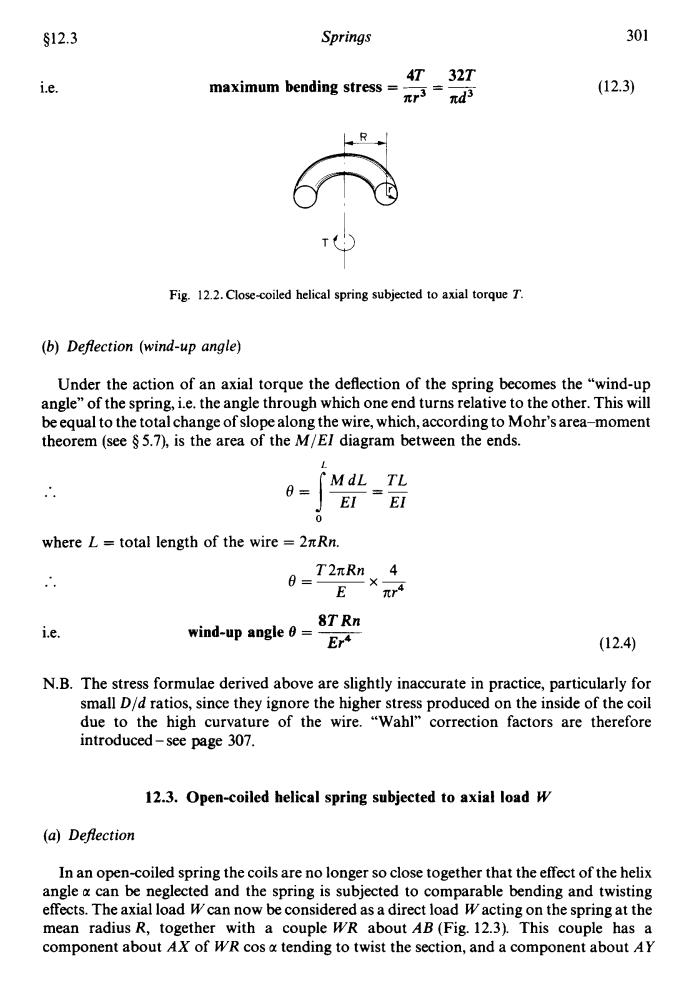正在加载图片...

§12.3 Springs 301 4T32T i.e. maximum bending stress= nd3 (12.3) Fig.12.2.Close-coiled helical spring subjected to axial torque T. (b)Deflection (wind-up angle) Under the action of an axial torque the deflection of the spring becomes the "wind-up angle"of the spring,i.e.the angle through which one end turns relative to the other.This will be equal to the total change of slope along the wire,which,according to Mohr's area-moment theorem (see $5.7),is the area of the M/EI diagram between the ends. 0= MdL TL EI EI 0 where L total length of the wire =2Rn. 0=T2πRm、4 4 8TRn i.e. wind-up angle 0 = Er4 (12.4) N.B.The stress formulae derived above are slightly inaccurate in practice,particularly for small D/d ratios,since they ignore the higher stress produced on the inside of the coil due to the high curvature of the wire."Wahl"correction factors are therefore introduced-see page 307. 12.3.Open-coiled helical spring subjected to axial load W (a)Deflection In an open-coiled spring the coils are no longer so close together that the effect of the helix angle a can be neglected and the spring is subjected to comparable bending and twisting effects.The axial load Wcan now be considered as a direct load Wacting on the spring at the mean radius R,together with a couple WR about AB(Fig.12.3).This couple has a component about AX of WR cos a tending to twist the section,and a component about AY912.3 Springs i.e. 4T 32T maximum bending stress = ~ - __ nr3 - nd3 301 (12.3) Fig. 12.2. Closecoiled helical spring subjected to axial torque T. (b) Defection (wind-up angle) Under the action of an axial torque the deflection of the spring becomes the “wind-up angle” of the spring, i.e. the angle through which one end turns relative to the other. This will be equal to the total change of slope along the wire, which, according to Mohr’s area-moment theorem (see 9 5.7), is the area of the M/EZ diagram between the ends. L .. e=jF== MdL TL 0 where L = total length of the wire = 2nRn. .. e=- XE nr4 T2nRn 4 i.e. 8T Rn wind-up angle 8 = ~ Er4 (12.4) N.B. The stress formulae derived above are slightly inaccurate in practice, particularly for small D/d ratios, since they ignore the higher stress produced on the inside of the coil due to the high curvature of the wire. “Wahl” correction factors are therefore introduced - see page 307. 12.3. Open-coiled helical spring subjected to axial load W (a) Defection In an opencoiled spring the coils are no longer so close together that the effect of the helix angle a can be neglected and the spring is subjected to comparable bending and twisting effects. The axial load Wcan now be considered as a direct load Wacting on the spring at the mean radius R, together with a couple WR about AB (Fig. 12.3). This couple has a component about AX of WR cos a tending to twist the section, and a component about AY